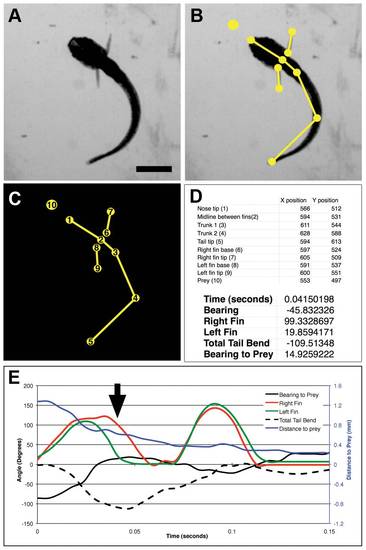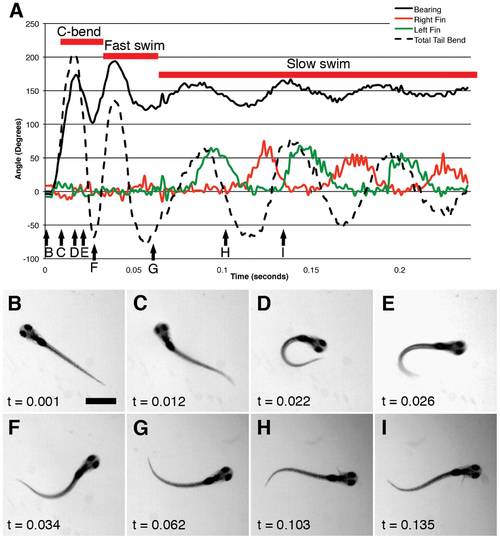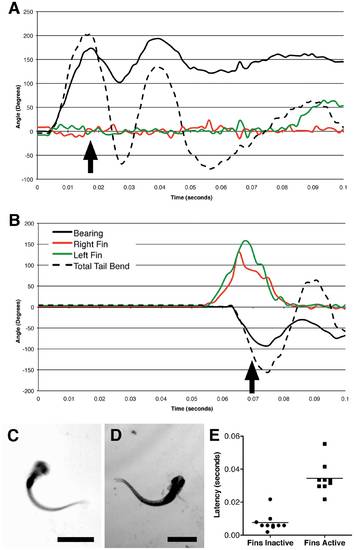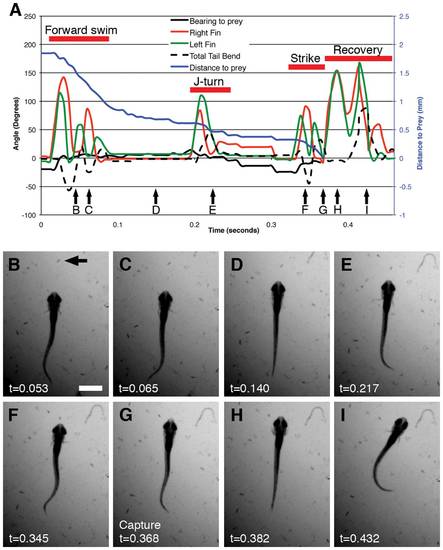- Title
-
Fin-Tail Coordination during Escape and Predatory Behavior in Larval Zebrafish
- Authors
- McClenahan, P., Troup, M., and Scott, E.K.
- Source
- Full text @ PLoS One
|
Method of kinematic analysis. Panel A shows a single frame from a high-speed movie of a 14 dpf larva that is pursuing a prey item, in this case a paramecium. In panel B, ten landmarks have been manually placed on the larva and prey. Panel C shows the resulting point-and-line representation of the larva and prey, with numbers automatically assigned to each point. The XY coordinates of each point are shown in panel D, along with automatically extracted information on the larva′s fins, tail, and position relative to the paramecium. Panel E shows a portion of the overall pursuit and capture event, indicating the tail bend, extension of each fin, and distance and bearing to the paramecium through time. The arrow indicates the frame represented in panels A–D. Scale bar in A represents 1 mm. |
|
Overall structure of larval startle. The bearing (0° at t = 0), tail bend angle, and pectoral fin extensions are shown for the entirety of a response to a startling auditory stimulus (Panel A). Individual frames from the behavior are shown in Panels B–I), with accompanying timestamps. The approximate time for each of these frames is indicated by an arrow in Panel A. This startle event is composed of three phases, a rapid high-amplitude bend of the tail (C-bend), a strong counter bend and tail beat (fast swim), and then a slower, less dramatic alternating tail beat accompanied by pectoral fin extensions (slow swim). Scale bar in B represents 1 mm. The larva shown is 7 dpf. |
|
Pectoral fin involvement in long-latency, but not short-latency startle. Charts representing typical short-latency (Panel A) and long-latency (Panel B) startle responses are shown. In short-latency startle responses, the fins remain adducted during the C-bend and counter bend. Both pectoral fins are abducted and adducted in unison during the C-bend and counter bend of long-latency startles. Individual frames from a short-latency (Panel C) and a long-latency startle (Panel D) are shown, with the approximate times of the frames indicated by the arrows in Panels A and B. Panel E shows a scatter plot of startle events with and without fin involvement, and the latency to respond to the stimulus. n = 9 for responses with active fins and 10 for inactive fins, and p<0.0001 (two-tailed unpaired t-test). Scale bars in C and D indicate 1 mm. The larvae shown are 7 dpf. |
|
Components of prey capture. The chart in panel A shows a larva′s pursuit and capture of a paramecium (arrow, B). The individual elements of the behavior are indicated by red lines. Panels B–I show individual frames from the movie of this sequence, with approximate times of the frames indicated by arrows in Panel A. The paramecium is indicated with an arrow in panel B, and all panels show the same field of view. Panels B and C show opposite tail bends of a forward swim, with extensions of the outside pectoral fin in each case. The larva pauses in panel D. Panel E shows the unilateral tail bend typical of a J-turn, with the outside pectoral fin extended. An S-bend is seen in panel F, which leads to the capture of the paramecium in panel G. Strong abductions of both pectoral fins are seen immediately after capture (Panel H), before the larva turns and swims away (Panel I). Time stamps are shown for each panel. The scale bar in B represents 1 mm. The larva shown is 7 dpf. |




